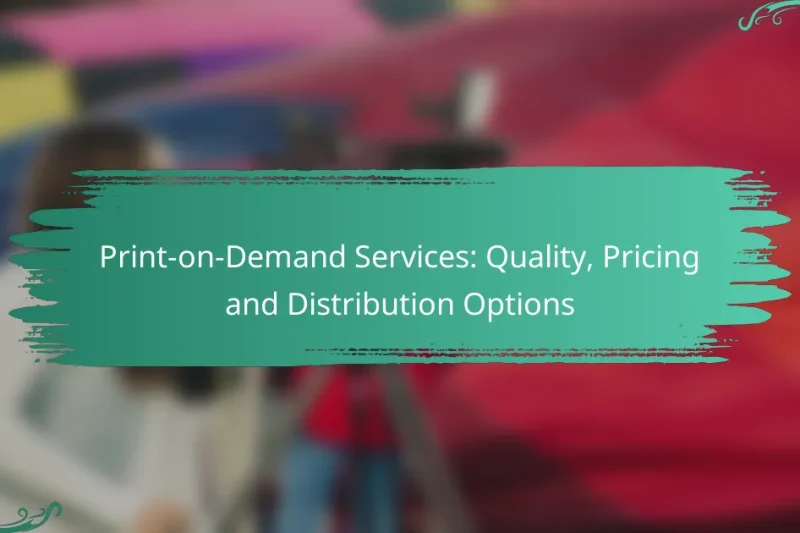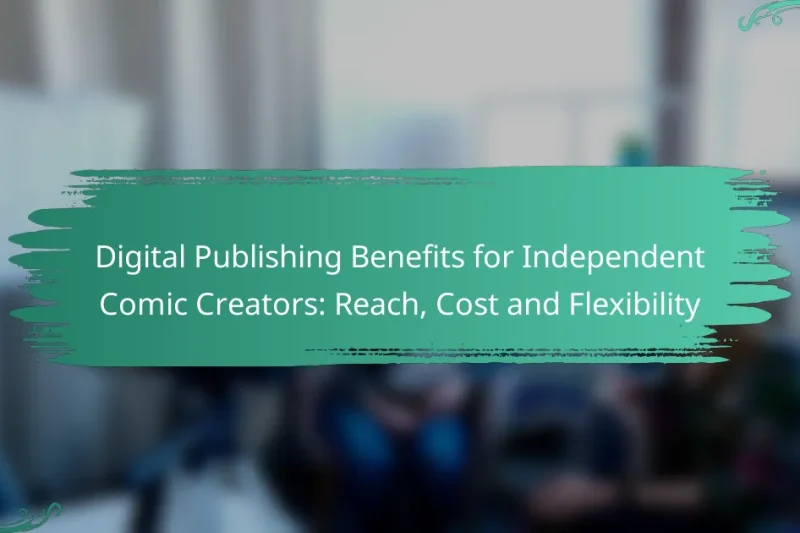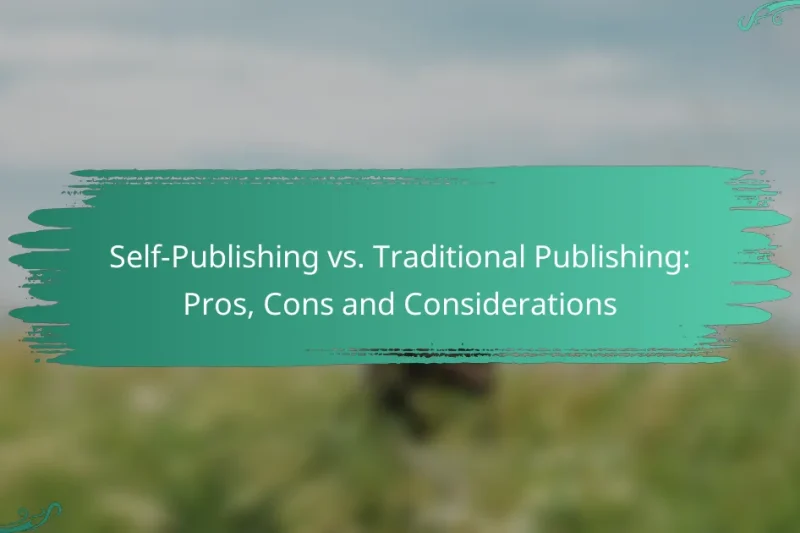Copyright and licensing are essential for comic creators, providing automatic protection for their original works such … Copyright and Licensing for Comic Creators: Protection, Registration and EnforcementRead more
Hench Girl Comics: Publishing Options for Independents
Hench Girl comics offer independent creators a variety of publishing options, including digital self-publishing, print-on-demand services, and traditional publishing houses. Each method presents unique benefits and challenges that can influence the comic’s success and profitability. By understanding these avenues and effectively marketing through social media and collaborations, creators can enhance their visibility and engage with their audience.
Print-on-Demand Services: Quality, Pricing and Distribution Options
Print-on-demand services have revolutionized the way creators and businesses produce and sell custom products, offering a … Print-on-Demand Services: Quality, Pricing and Distribution OptionsRead more
Choosing the Right Platform for Hench Girl Comics: Features, Costs and Support
Choosing the right platform for Hench Girl Comics is essential for maximizing your creative potential and … Choosing the Right Platform for Hench Girl Comics: Features, Costs and SupportRead more
Digital Publishing Benefits for Independent Comic Creators: Reach, Cost and Flexibility
Digital publishing provides independent comic creators with the opportunity to reach a wider audience, reduce costs, … Digital Publishing Benefits for Independent Comic Creators: Reach, Cost and FlexibilityRead more
Self-Publishing vs. Traditional Publishing: Pros, Cons and Considerations
The choice between self-publishing and traditional publishing is a pivotal decision for authors, each path offering … Self-Publishing vs. Traditional Publishing: Pros, Cons and ConsiderationsRead more
Comic Distribution Challenges in International Markets: Regulations, Logistics and Audience
Comic distribution in international markets presents unique challenges, including navigating complex regulations, managing logistical intricacies, and … Comic Distribution Challenges in International Markets: Regulations, Logistics and AudienceRead more
What are the best publishing options for Hench Girl comics in the US?
The best publishing options for Hench Girl comics in the US include digital self-publishing platforms, print-on-demand services, and traditional publishing houses. Each option has its own advantages and considerations that can impact the reach and profitability of your comic.
Digital self-publishing platforms
Digital self-publishing platforms allow creators to publish and distribute their comics online without the need for a traditional publisher. Popular platforms include Amazon Kindle Direct Publishing, ComiXology, and Webtoon, which cater to different audiences and formats.
When choosing a platform, consider factors like royalty rates, audience size, and ease of use. For instance, platforms like Webtoon focus on webcomics and may offer a more engaged audience, while Kindle Direct Publishing can reach a broader readership through e-books.
Print-on-demand services
Print-on-demand (POD) services enable creators to print physical copies of their comics only when orders are placed, minimizing upfront costs. Services like Lulu, Blurb, and IngramSpark are popular choices for independent comic creators.
Using POD can be cost-effective, as you avoid large print runs and storage issues. However, be mindful of printing costs and shipping times, which can affect your pricing strategy and delivery to customers.
Traditional publishing houses
Traditional publishing houses offer the advantage of established distribution networks and marketing support, which can significantly boost visibility for Hench Girl comics. However, securing a deal often requires a strong pitch and may involve lengthy submission processes.
Consider targeting smaller or independent publishers that specialize in comics, as they may be more receptive to unique projects. Be prepared for potential profit-sharing arrangements and the possibility of creative input from the publisher.
How can independent creators market Hench Girl comics effectively?
Independent creators can market Hench Girl comics effectively by leveraging social media, collaborating with influencers, and participating in online comic conventions. These strategies help build an audience, increase visibility, and foster community engagement.
Social media marketing strategies
Utilizing social media platforms like Instagram, Twitter, and Facebook is crucial for independent creators. Regularly posting engaging content, such as artwork, behind-the-scenes processes, and character insights, can attract followers and potential readers.
Consider using targeted ads to reach specific demographics interested in comics. Engaging with followers through comments and direct messages can also create a loyal fan base. Aim for consistent posting schedules to maintain visibility.
Collaborations with influencers
Partnering with influencers in the comic book community can significantly enhance visibility. Look for influencers who resonate with your target audience and have a genuine interest in your work.
Collaborations can include guest appearances on podcasts, joint social media campaigns, or even co-hosting live events. Ensure that the influencer’s style aligns with your comic’s themes to create authentic promotional content.
Online comic conventions
Participating in online comic conventions offers a unique opportunity to showcase Hench Girl comics. These events often feature panels, workshops, and virtual booths, allowing creators to connect with fans and other artists.
Prepare promotional materials, such as digital flyers or exclusive online content, to attract attendees to your booth. Engage with the audience during live streams or Q&A sessions to create a memorable experience that encourages them to support your work.
What are the costs associated with publishing Hench Girl comics?
Publishing Hench Girl comics involves several costs that independent creators should consider, including production, marketing, and distribution expenses. Understanding these costs can help you budget effectively and maximize your comic’s reach.
Self-publishing expenses
Self-publishing costs can vary widely based on your choices. Key expenses include artwork, printing, and editing. For instance, hiring an artist may range from a few hundred to several thousand dollars, depending on their experience and the complexity of the artwork.
Additionally, printing costs depend on the number of copies and the quality of materials. A small print run of 100 copies might cost around $500 to $1,500, while larger runs can reduce the per-unit cost significantly. Consider digital formats as well, which can lower upfront costs.
Marketing budget considerations
Marketing is essential for gaining visibility for your Hench Girl comics. A reasonable marketing budget could range from a few hundred to several thousand dollars, depending on your strategy. Social media advertising, influencer partnerships, and attending conventions are common avenues for promotion.
Allocate funds for creating promotional materials, such as posters or digital ads. Engaging with your audience through platforms like Instagram or Twitter can also be cost-effective, but it requires time and consistent effort to build a following.
Distribution fees
Distribution fees can impact your overall budget significantly. If you choose to work with a distributor, they typically take a percentage of sales, often around 30-50%. This fee can vary based on the distributor’s reach and services offered.
For direct sales through your website or platforms like Etsy, consider transaction fees and shipping costs. Shipping can add up, especially for international orders, so factor these into your pricing strategy to maintain profitability.
What are the key factors to consider when choosing a publishing route?
When selecting a publishing route for Hench Girl comics, consider factors such as target audience alignment, creative control, and revenue potential. Each of these elements can significantly influence the success and sustainability of your comic project.
Target audience alignment
Understanding your target audience is crucial for choosing the right publishing route. Consider whether your comic appeals more to niche markets or broader demographics, as this will guide your platform selection. For example, independent comics may thrive on platforms like Kickstarter or webtoons, while mainstream audiences might be better served through traditional publishers.
Researching where your audience engages with content can help you make informed decisions. Utilize social media analytics and comic forums to gauge interest and preferences, ensuring your publishing choice resonates with potential readers.
Creative control
Creative control refers to the extent to which you can influence the content and presentation of your comic. Independent publishing generally offers greater creative freedom compared to traditional routes, where publishers may impose restrictions on storylines, art styles, or marketing strategies. If maintaining your original vision is essential, consider self-publishing or partnering with smaller publishers.
However, with increased control often comes added responsibility. Weigh the benefits of creative autonomy against the challenges of managing production, distribution, and marketing. Establishing a clear plan can help you navigate these complexities effectively.
Revenue potential
Revenue potential varies significantly across different publishing routes. Traditional publishing may offer upfront advances but often takes a larger cut of sales, while self-publishing can lead to higher profit margins but requires more investment in marketing and distribution. Assess your financial goals and choose a route that aligns with your expectations.
For instance, crowdfunding platforms can provide initial funding and gauge interest, but they require ongoing engagement with backers. Consider creating a budget that outlines potential costs and revenue streams to make informed decisions about your publishing strategy.
What are the emerging trends in independent comic publishing?
Independent comic publishing is witnessing several key trends that are shaping how creators distribute and monetize their work. Notable trends include the rise of webcomics, successful crowdfunding campaigns, and the incorporation of multimedia elements into storytelling.
Growth of webcomics
The growth of webcomics has transformed the landscape for independent creators, allowing them to reach global audiences without traditional publishing barriers. Platforms like Webtoon and Tapas enable artists to publish their work online, often for free, while monetizing through ads or reader donations.
Creators can experiment with different styles and formats, gaining instant feedback from readers. This immediacy fosters a community around the comic, enhancing reader engagement and loyalty.
Increased crowdfunding success
Crowdfunding has become a vital tool for independent comic creators, with platforms like Kickstarter and Indiegogo facilitating funding for projects that might not find backing through traditional means. Successful campaigns often raise thousands of dollars, allowing creators to cover production costs and reach their audience directly.
To maximize crowdfunding success, creators should set realistic funding goals, offer enticing rewards, and actively promote their campaigns through social media. Engaging with backers and maintaining transparency throughout the process can significantly enhance trust and support.
Integration of multimedia elements
Integrating multimedia elements into comics is an emerging trend that enriches storytelling and enhances reader experience. Creators are increasingly incorporating animations, sound effects, and interactive features into their work, particularly in webcomics.
This multimedia approach can attract a broader audience, as it appeals to those who enjoy dynamic and immersive content. However, creators should balance these elements with the core comic narrative to avoid overwhelming readers and maintain clarity in storytelling.





